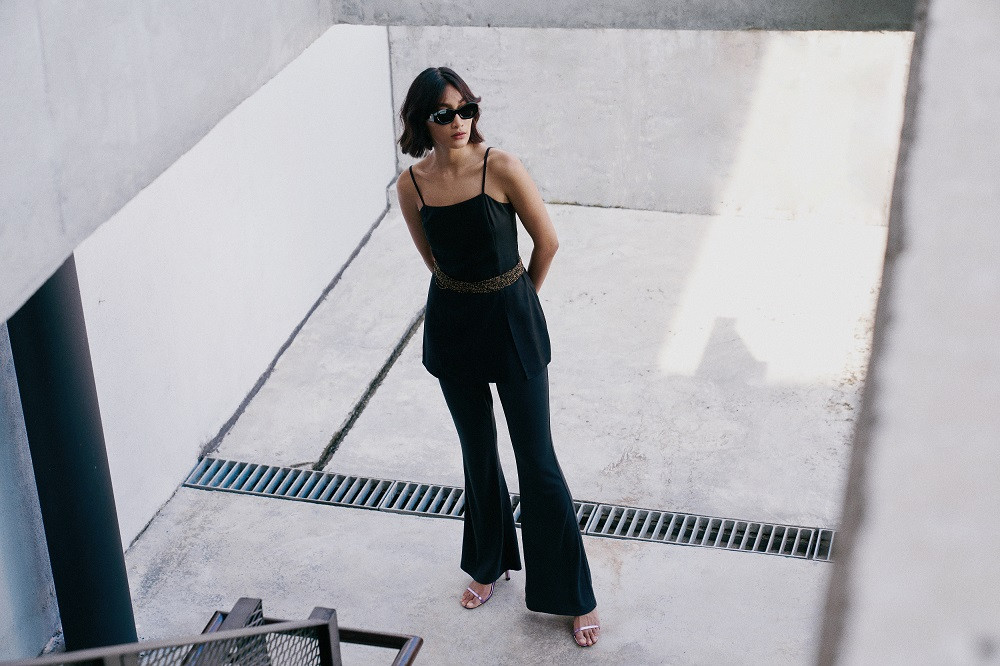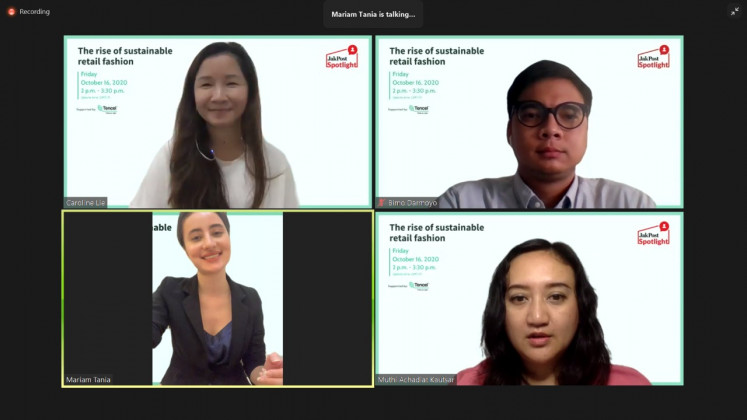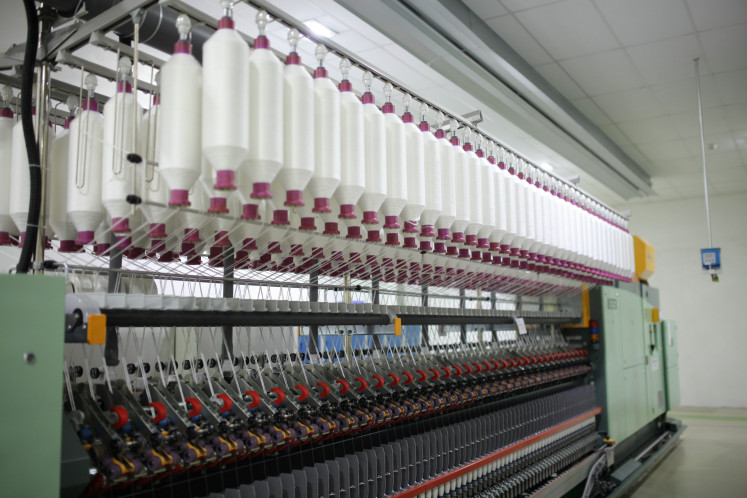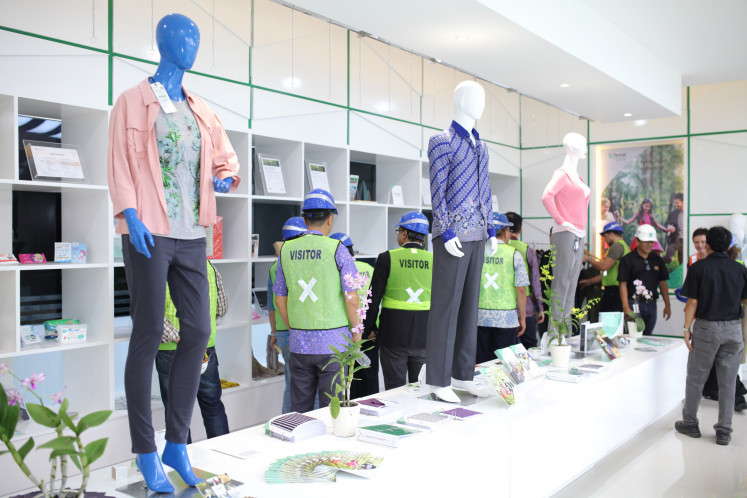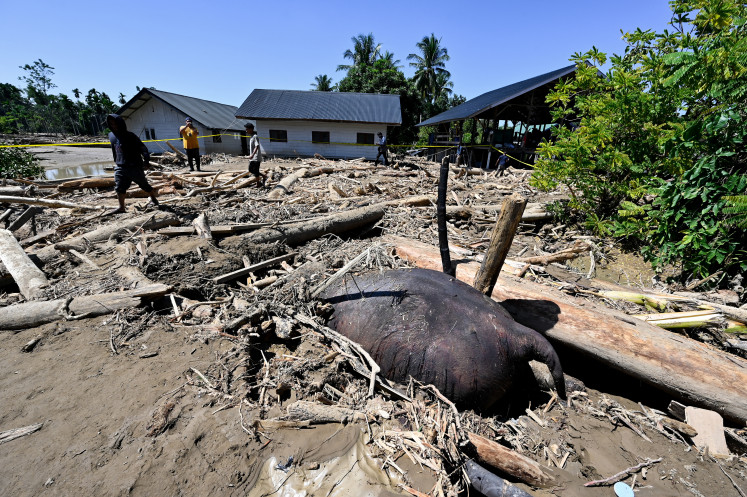Popular Reads
Top Results
Can't find what you're looking for?
View all search resultsPopular Reads
Top Results
Can't find what you're looking for?
View all search resultsSustainable fashion trend rises along with e-commerce during COVID-19
When people’s awareness of sustainability and escalating fashion e-commerce join forces, the result is a rise in demand for sustainable fashion on the online retail landscape. Sustainable fashion incorporates manufacturing and production, which seeks to use biodegradable materials and reduce carbon emissions, among other things.
Change text size
Gift Premium Articles
to Anyone
W
hile accelerating the digitization of businesses, the COVID-19 pandemic has also increased the global public’s awareness on the importance of protecting the environment, which has translated into the rise of ecologically sustainable business operations.
The two-pronged changes that the COVID-19 pandemic has brought to businesses have affected the fashion industry as well. With shrinking brick-and-mortar retail activities, more fashion brands have been selling their products online, including in Indonesia.
Demand for sustainable fashion has also never been stronger, with more and more people becoming aware that fashion production makes up 10 percent of humanity’s carbon emissions, according to the Fashion Revolution Day website. Meanwhile, the same source said about 85 percent of all textiles ended up in the dump each year.
When people’s awareness of sustainability and escalating fashion e-commerce join forces, the result is a rise in demand for sustainable fashion on the online retail landscape. Sustainable fashion incorporates manufacturing and production, which seeks to use biodegradable materials and reduce carbon emissions, among other things.
Seeking to capitalize on this new trend, industries are on the race toward incorporating concrete environmental sustainability measures into their entire supply chain, making sure that their efforts go beyond the mere “greenwashing” marketing ploy.
At the same time, they are also striving to familiarize more of their consumers about what sustainable fashion production truly entails and how to find these products in the marketplace.
The following is a summary of a recent JakPost Spotlight webinar hosted by The Jakarta Post titled “The Rise of Sustainable Retail Fashion”, held on Oct. 16 from 2 to 3:30 p.m. in collaboration with cellulosic fiber brand TENCEL.
Energizing the positive trend of sustainable fashion: JakPost Spotlight webinar, held on Oct. 16, focused on the theme “The Rise of Sustainable Retail Fashion”. The webinar was facilitated by three speakers, namely Mariam Tania (bottom left), Southeast Asia and Oceania marketing and branding manager of the LENZING Group, Caroline Lie (top left), Indonesia country head of Omnilytics and Bimo Darmoyo (top right), marketing associate director of ZALORA Indonesia. (JP/File)The webinar was facilitated by three speakers. The first speaker, Mariam Tania, is the Southeast Asia and Oceania marketing and brand manager of Lenzing Group, in which Tencel is its flagship brand for textiles. The second speaker was Caroline Lie, the Indonesia country head of Omnilytics, a fashion market analytics and insight software. The third speaker, Bimo Darmoyo, is the marketing associate director of e-retailer ZALORA Indonesia.
Mariam opened her presentation by showing a Google Trends data, indicating a dramatic increase in demand for sustainable fashion and sustainable fabric worldwide from January 2010 to March 2020, driven by both consumers and industry professionals/enthusiasts.
The highest spike in demand occurred in March 2020, at a time when the coronavirus outbreak had increased people’s awareness on the importance of conserving the ecosystem.
This trend, she said, had also driven demand for Tencel fibers, which are cellulosic fibers derived from renewable wood sources, which revolutionize the textile industry, offering long-lasting comfort to fabrics with an exquisitely soft hand-feel.
Moreover, clothes made of cellulosic fibers were more biodegradable, and there was a question from a participant about whether it affected its lifespan.
Mariam explained that in fact, the material was strong.
“The lifespan will be shorter, [in terms of] if you bury the clothes [in the soil], it will biodegrade, because of the natural chemical process in the soil,” said Mariam, adding that if you keep them, clothes with Tencel fiber is stronger than those with other natural fibers.
A question from another participant, Maretta Putri, was whether the price of sustainable clothing material was competitive in the market.
According to Mariam, there may be assumptions that sustainable fashion and the clothing materials were very expensive, but actually there were different price ranges, especially as the Tencel fibers could also be blended with other fibers to bring down prices, for instance.
Mariam said, “You can see the variety of prices [of items made with Tencel fibers] in the market […], check the collaborations with the brands on Tencel Indonesia’s Instagram account @tencel_indonesia, [where] you can look at the variety of brands, including the price.”
Caroline, meanwhile, said her company’s data had also affirmed that this rising trend of sustainable fashion had also taken place locally, whereby the rising demand for activewear that these fashion brands offered online also went hand-in-hand with the rise in demand for sustainable fashion.
She said that in April and May, at the beginning of the pandemic, initially fashion brands panicked to quickly clear out their inventory, prompting them to lower prices and offer discounts to entice buyers to buy their products. At the same time, they also swiftly switched their distribution and sales programs to focus on boosting their online presence.
She added that during the initial months of the pandemic, these brands were quite worried about declining demand, yet a few months later into the stay-at-home period, consumer demand had started to pick up again online, especially for activewear, including loungewear collections, webcam-ready looks and at-home, at-ease clothing, which consumers needed to conduct their social and business activities online.
Activewear registered 30.88 percent sellout, stronger than the average sell-out percentage, based on the Omnilytics data regarding online fashion consumer behavior during the pandemic.
“With this, the fashion brands have gained more confidence to stock more products on their [online] channels, seeing that consumers continue to purchase their products on the channel,” Caroline said.
With this switch, she continued, brands had increasingly packaged their campaigns around the message for buyers to just stay home, while catering to their needs for activewear. T-shirts and flip-flops have also become popular items among fashion consumers, according to Caroline.
When purchasing these products, apparently more and more of these homebound consumers prefer the sustainably manufactured ones to any other products.
“Continuing the increase recorded in March 2020, demand for Tencel products, for instance, has progressively increased from April to September 2020, what does this mean? The trend of sustainable products has well been accepted for our product,” Caroline explained.
The current increase in demand for sustainable fashion was also thanks to the campaigns conducted by various brands to familiarize people on its importance.
On display: LENZING Group, Austria-based natural fibers producer in which TENCEL is the flagship brand, have representatives around the world, with one factory in Purwakarta, West Java. Visitors are welcome to observe a display area in the factory, featuring samples of textiles and clothes made using TENCEL fibers. (Courtesy of/TENCEL)Online fashion retailer ZALORA Indonesia marketing associate director Bimo Darmoyo said the platform was taking part in a continuous endeavor to educate its consumers on sustainable fashion products, hoping to mainstream the awareness about the issues among even more people.
For instance, Bimo said, ZALORA Indonesia had a campaign for its sustainability programs, including measuring its value chain’s global carbon footprint, from manufacturing to transportation, to define the baseline of its long-term carbon reduction goal and mainstream eco-friendly packaging.
In its warehouses, the company also implements waste reduction and recycling plans, while implementing energy efficiency initiatives in all its warehouses and investigate possible renewable energy options for its operations.
The webinar drew various interesting questions from its participants, who represented market research companies, fashion startups and industry players, as well as university students majoring in business marketing and environmental sciences.
The multidisciplinary questions raised by the participants – covering the business, environment and technology aspects of sustainable fashion – truly highlight the need of multi-stakeholder collaboration to take this current demand increase of sustainable fashion to the next high.
This is important to ensure a better future, both for the fashion industry and the environment.

